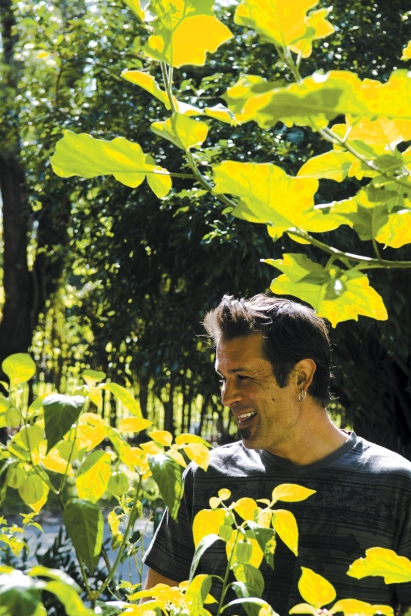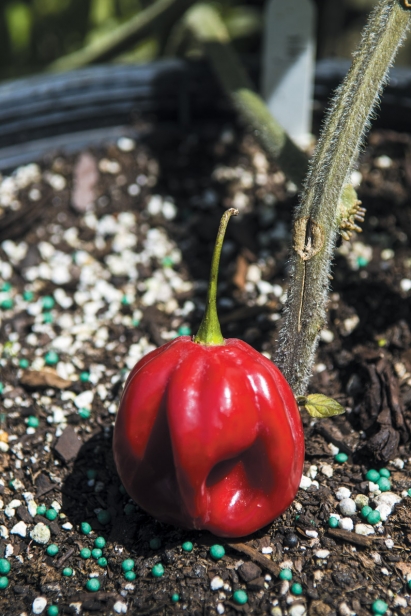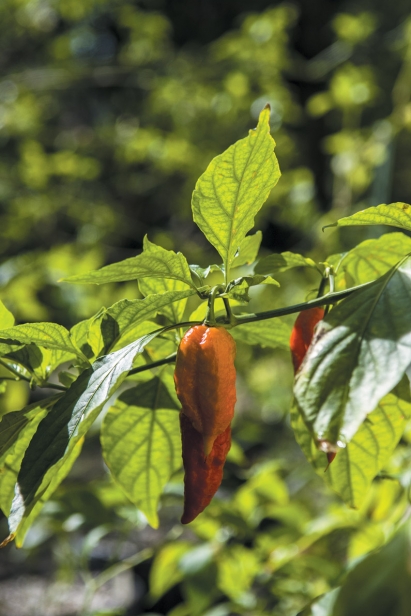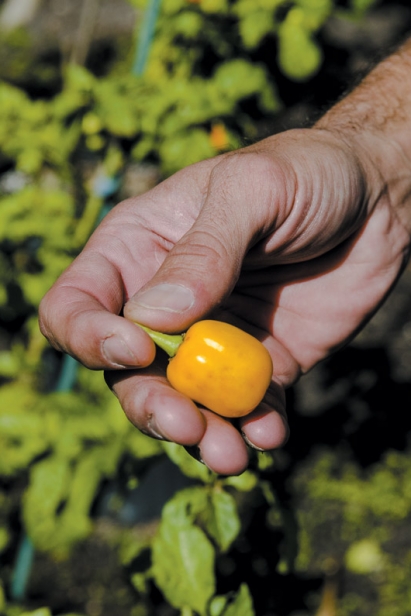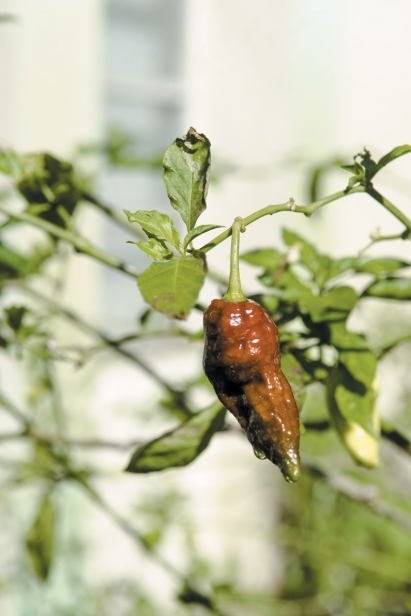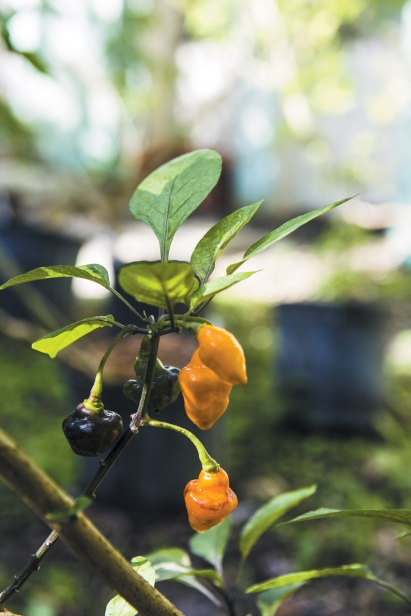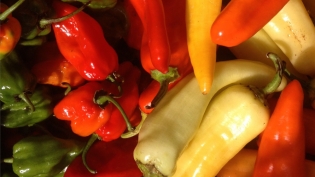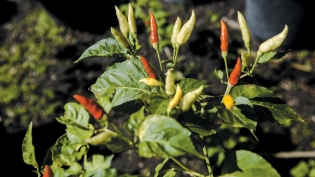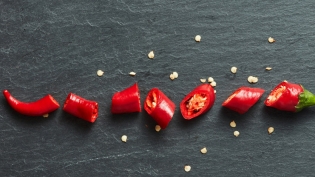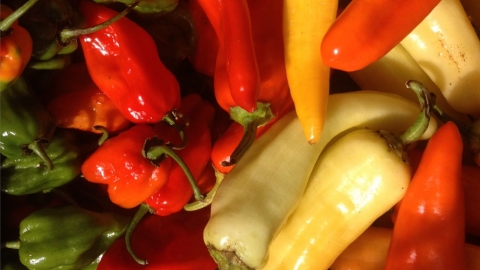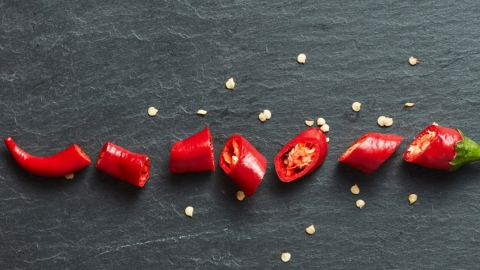Pick a Peck of Peppers
On a quiet corner in South Miami within earshot of the low rumble of passing Metrorail trains, Mike Heckart walks among hundreds of potted plants in the driveway and around the house. Most of them are chile peppers – varieties that are mild, sweet, kinda hot, really hot and, well, the hottest on the planet. And Heckart has eaten every different pepper he’s grown.
Heckart, who turns 41 in August, did not grow up eating hot peppers. Born in Lancaster, Pennsylvania, he was 2 when the family moved to Florida City. Raised by his mother after his parents divorced, Heckart remembers going with his brother every Friday to the corner grocery store on SW 264th St. and 187th Ave. to get a candy bar. “We worked hard, got our chores done, did our homework.” His mother, a horticulturist on a 27-acre ornamental farm, encouraged his interest in plants, and when he was 8 he was growing heirloom vegetables in pots on the patio.
But school interested him less – “I didn’t do well in school” – and by the time he graduated from FIU with a degree in English, he still didn’t know what he wanted to do with his life. He was accepted to FIU’s grad program and started teaching in private and public schools in Miami-Dade and Palm Beach counties. After school, he got his hands dirty in a community garden. “I worked all day, then gardened till dark, growing everything he could.”
He’d had enough as a teacher and moved back to Miami. What interested him most in gardening was the Solanaceae, the nightshade family that includes tomatoes, peppers, eggplant and potatoes, and other plants, some edible, some poisonous, some medicinal. The Capsicum genus caught his attention, though initially he “wasn’t into crazy hot foods,” says Heckart. “I was entranced by the variety, the shapes and the colors.” The first year, he dabbled in the superhots – Capsicum chinense, the species that includes the scorpion peppers, the ghost chile, Scotch bonnets and 7-pot chiles, among the hottest in the world.
He remembers eating a superhot pepper for the first time: the mouth-searing Moruga Scorpion. “I have to be able to tell people what it tastes like,” he says. So he ate a whole pod to review it.
“There’s an immediate stinging pain. Ferocious. As painful as it is immediately, you have to give it time, 1-2 minutes. It’s like live yellowjackets in your mouth.”
“The real effects come after you swallow. Dihydrocapsaicin produces the back-of-the-throat burn. You can’t breathe. You try to catch your breath. You get hiccups. You can feel the burn all the way down. Then comes the gut bomb effect: cramps, digestive distress.
“I didn’t go near anything spicy after that for months.”
When Heckart came back to eating peppers, he started out more slowly and worked his way toward building his tolerance for heat. Meanwhile, he continued collecting plants and connected with other hot pepper aficionados, known as Chiliheads, on online forums where they share knowledge, trade seeds and support each other. “There’s cultural tolerance and respect – that’s our tribe. We get together and geek out.” He told how the group came together to raise funds for a member of the group diagnosed with leukemia. “They sold seeds, hot sauce, pepper jelly to raise money to help him pay his bills,” he says. “It’s a good group of people.”
Back in the garden, Heckart points out some of the plants in his collection. Piquin peppers are “hot, but manageable.” 7-pot Douglah from Trinidad is one of the blazing 7-pot peppers, which got their name because it’s said that one pepper is enough to highly season seven pots. The variety C. baccatum ‘Jamy’ has an interesting property, he says: “The bottom tip of the pepper has no heat, but as you work your way up, it gets hotter.” It may surprise some to know there are no bell peppers growing here. “No interest at all,” says Heckart. “You only get a few peppers from the plant.” Instead, he recommends growing the Venezuelan tiger, sweet but not hot, that produces plenty of peppers year-round.
Among Heckart’s many potted plants is the rocoto pepper, one of the C. baccatum varieties that thrive in South and Central America but are notoriously difficult to grow here. “Their flavor is clean, bright, fresh, berry-like,” he says. He’s managed to get a pineapple rocoto, native to the Galapagos, to fruit here. “It really did taste of pineapple,” he says.
As mango expert and edible South Florida columnist Dr. Richard Campbell would say – “Tell me where you’re from, and I know what kind of mango you like” – Heckart can do the same with peppers. Are you Venezuelan? “It’s ají dulce.” Similarly, ají cachucha is the favorite seasoning for Cuban black beans. “Every country has its own take on peppers with little to no heat,” he says.
Heckart keeps busy sharing his expertise through speaking engagements at garden clubs, fruit and vegetable groups, botanical gardens, including the Miami Beach Botanical Garden, home to a pepper collection; The Kampong and Fairchild Tropical Botanic Garden. His business, Wicked Mike’s, sells peppers and rare edible and medicinal plants. Like many passionate plant lovers, he does have his eye on a future trip to South America, specifically to Bolivia to harvest Capsicum cardenasii in the wild – “it’s believed to be the progenitor of all peppers.” Stay tuned for the next episode in the pepper adventure.
Visit Wicked Mike's online



